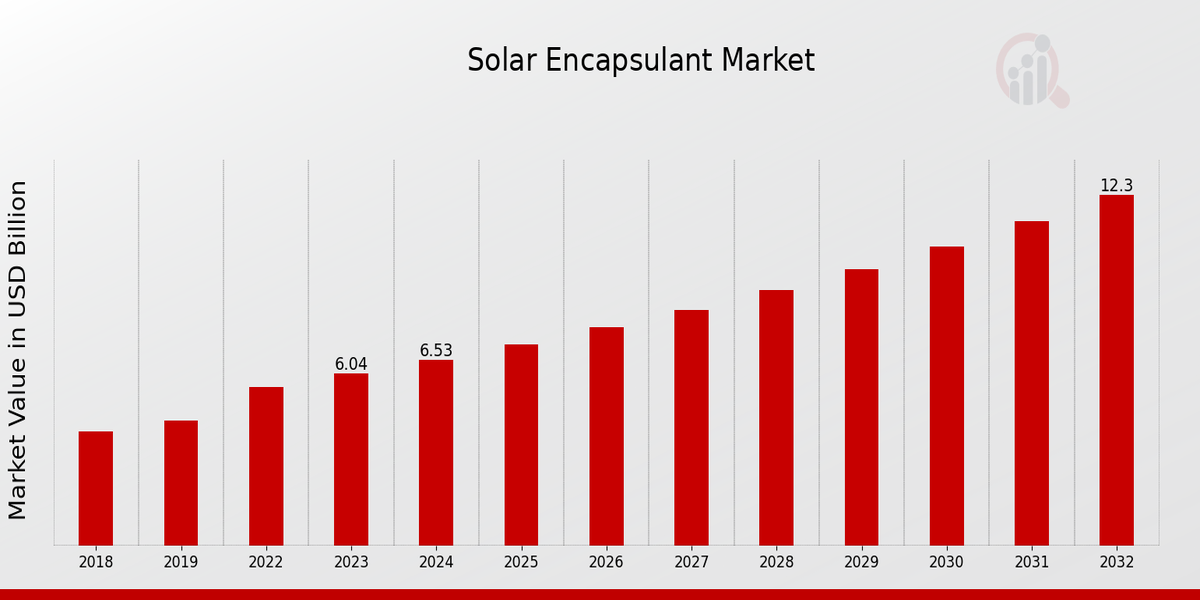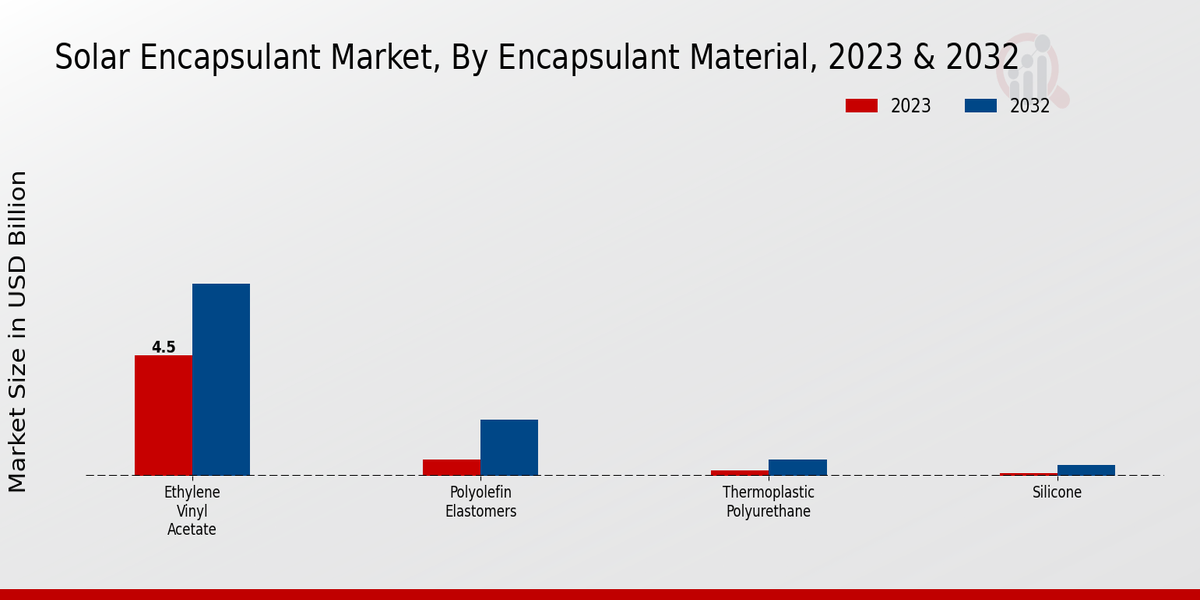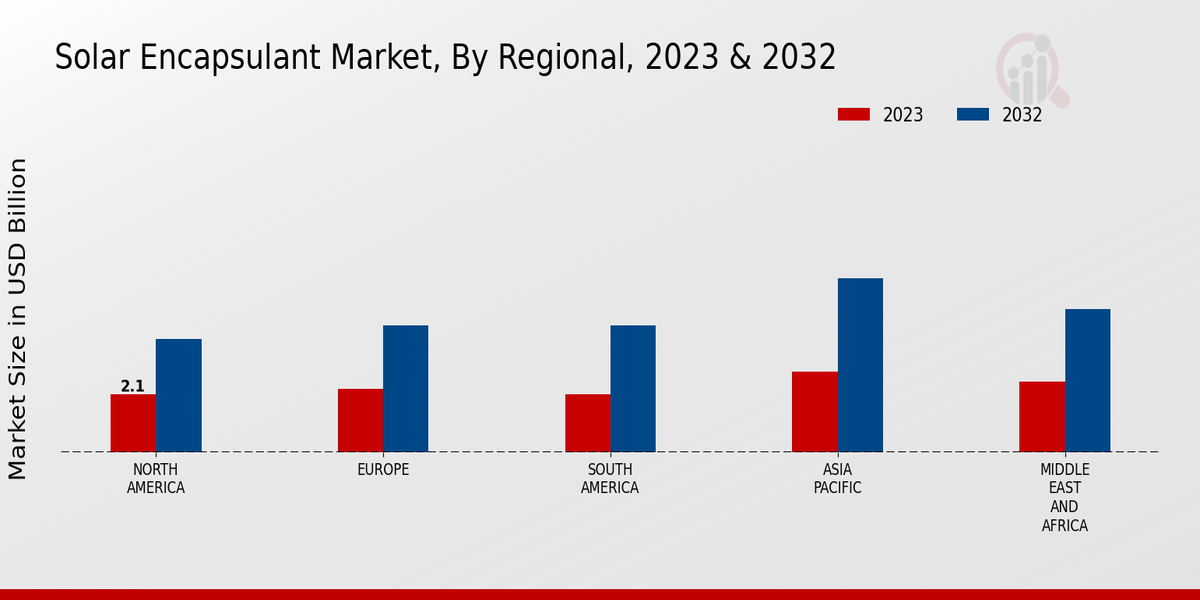Global Solar Encapsulant Market Overview
As per MRFR analysis, the Solar Encapsulant Market Size was estimated at 7.07 (USD Billion) in 2024. The Solar Encapsulant Market Industry is expected to grow from 7.66 (USD Billion) in 2025 to 15.60 (USD Billion) till 2034, at a CAGR (growth rate) is expected to be around 8.23% during the forecast period (2025 - 2034).
Key Solar Encapsulant Market Trends Highlighted
The Solar Encapsulant Market is being fueled by governments encouraging the use of renewable sources of energy, the rising installation of solar panels, and the growing concern over environmental issues. Popular opportunities in the solar encapsulants market are the new technological developments in solar encapsulation, further expansion into developing regions, and the use of solar energy for new kinds of purposes. More recently, there has been demand for the use of high-performance encapsulants, the search for eco-friendly materials, and encapsulants such as those aimed at flexible solar applications. The major participants in the market are actively engaged in the research to develop new solutions that increase the practical application of the encapsulants and their effectiveness in light of the solar market’s requirements.

Source: Primary Research, Secondary Research, MRFR Database and Analyst Review
Solar Encapsulant Market Drivers
Rising Demand for Solar Energy
The Solar Encapsulant Market is primarily driven by the increasing demand for solar energy. Solar energy is a clean, renewable, and sustainable source of energy that is becoming increasingly popular as concerns about climate change grow. Solar panels are used to convert sunlight into electricity, and solar encapsulants are essential components of solar panels. They protect the solar cells from environmental factors such as moisture, dust, and UV radiation, ensuring the long-term performance and reliability of solar panels.
The rising demand for solar energy is being driven by a number of factors, including Government incentives: Many governments around the world are offering incentives to businesses and consumers to install solar panels. These incentives include tax breaks, rebates, and feed-in tariffs. Corporate sustainability goals: Many corporations are setting sustainability goals that include reducing their carbon footprint. Solar energy can help corporations meet these goals. Increasing consumer awareness: Consumers are becoming increasingly aware of the environmental benefits of solar energy. This awareness is leading to increased demand for solar panels.
The rising demand for solar energy is expected to continue in the coming years. This will lead to increased demand for solar encapsulants. The Solar Encapsulant Market is expected to grow from USD 6.04 billion in 2023 to USD 12.3 billion by 2032, at a CAGR of 8.23%.
Technological Advancements
The Solar Encapsulant Market is also being driven by technological advancements. Solar encapsulants are constantly being improved to improve their performance and durability. For example, new encapsulants are being developed that are more resistant to UV radiation and moisture. These advancements are making solar panels more efficient and reliable, which is leading to increased demand for solar encapsulants.
Growing Adoption of Building-Integrated Photovoltaics (BIPV)
The Solar Encapsulant Market is also being driven by the growing adoption of building-integrated photovoltaics (BIPV). BIPV is the integration of solar panels into the building envelope. This can be done by using solar panels as roofing tiles, curtain walls, or skylights. BIPV is becoming increasingly popular as it offers a number of benefits, including Improved aesthetics: BIPV can improve the aesthetics of a building. Increased energy efficiency: BIPV can help to reduce the energy consumption of a building.Reduced carbon footprint: BIPV can help to reduce the carbon footprint of a building. The growing adoption of BIPV is expected to continue in the coming years. This will lead to increased demand for solar encapsulants.
Solar Encapsulant Market Segment Insights:
Solar Encapsulant Market Encapsulant Material Insights
The Solar Encapsulant Market is segmented based on encapsulant material into Ethylene Vinyl Acetate (EVA), Polyolefin Elastomers (POE), Thermoplastic Polyurethane (TPU), and Silicone. Among these, EVA held the largest market share in 2023, accounting for over 85% of the global market revenue. The dominance of EVA can be attributed to its low cost, excellent adhesion properties, and long-term durability. However, POE is expected to witness significant growth in the coming years due to its superior resistance to moisture and UV degradation.The Solar Encapsulant Market for EVA is projected to grow from USD 4.5 billion in 2023 to USD 7.2 billion by 2032, at a CAGR of 6.2%. The growth of the EVA segment is primarily driven by the increasing demand for cost-effective and reliable encapsulants for solar modules. EVA encapsulants offer excellent adhesion properties and long-term durability, making them a preferred choice for manufacturers. The Solar Encapsulant Market for POE is expected to grow from USD 0.6 billion in 2023 to USD 2.1 billion by 2032 at a CAGR of 15.3%.The growth of the POE segment is mainly attributed to its superior resistance to moisture and UV degradation compared to EVA. POE encapsulants are highly durable and can withstand harsh environmental conditions, making them suitable for use in regions with extreme weather conditions. The Solar Encapsulant Market for TPU is projected to grow from USD 0.2 billion in 2023 to USD 0.6 billion by 2032 at a CAGR of 12.5%. The growth of the TPU segment is primarily driven by its excellent flexibility and high-temperature resistance. TPU encapsulants are suitable for use in flexible solar panels and applications where high-temperature stability is required.The Solar Encapsulant Market for Silicone is expected to grow from USD 0.1 billion in 2023 to USD 0.4 billion by 2032 at a CAGR of 14.2%. The growth of the Silicone segment is mainly attributed to its exceptional resistance to moisture, UV degradation, and high temperatures. Silicone encapsulants are highly durable and can withstand extreme environmental conditions, making them suitable for use in demanding applications such as aerospace and military.

Source: Primary Research, Secondary Research, MRFR Database and Analyst Review
Solar Encapsulant Market Cell Type Insights
The cell type segment plays a critical role in the overall Solar Encapsulant Market performance. Monocrystalline cells are anticipated to lead the Solar Encapsulant Market revenue with a notable market share in 2023. The high efficiency and durability of monocrystalline cells make them the preferred choice for various solar applications. Polycrystalline cells, with their cost-effective nature and reasonable efficiency, are projected to hold a significant portion of the Solar Encapsulant Market share. Thin-film cells, including amorphous silicon, cadmium telluride, and copper indium gallium selenide, are gaining traction due to their flexibility and lightweight properties, catering to specific market needs.The Solar Encapsulant Market segmentation provides valuable insights into the market dynamics, enabling stakeholders to make informed decisions and capitalize on growth opportunities.
Solar Encapsulant Market Application Insights
The application segment of the Solar Encapsulant Market holds significant importance in understanding the diverse applications of solar encapsulants in various sectors. Among the key applications, rooftop solar, ground-mounted solar, and building-integrated photovoltaics (BIPV) stand out as major contributors to market growth. Rooftop solar encapsulants cater to the rising demand for decentralized energy generation, enabling homeowners and businesses to harness solar power on their rooftops. This segment is expected to account for a substantial revenue share in 2023 and continue to grow steadily in the coming years, driven by government incentives and increasing awareness of renewable energy.Ground-mounted solar encapsulants play a crucial role in large-scale solar power plants, where solar panels are installed on the ground. This segment is poised to witness significant growth, driven by the increasing deployment of utility-scale solar projects worldwide. The growing focus on reducing carbon emissions and transitioning to clean energy sources is propelling the demand for ground-mounted solar encapsulants. Building-integrated photovoltaics (BIPV) encapsulants offer unique solutions for integrating solar panels into building structures, such as walls, roofs, and windows.This segment presents opportunities for architects and builders to create aesthetically pleasing and energy-efficient buildings. With the rising popularity of sustainable architecture and the need to reduce energy consumption in buildings, BIPV encapsulants are expected to witness strong growth in the coming years.
Solar Encapsulant Market End User Insights
The End User segment within the Solar Encapsulant Market presents diverse applications across various sectors, influencing the market growth. Residential installations hold a substantial market share, driven by the increasing adoption of rooftop solar systems for homes. Governments and utilities are actively promoting residential solar installations, contributing to the growth of this segment. Commercial and Industrial applications also account for a significant portion of the market as businesses seek energy independence and reduce operating costs.Utility-Scale Solar Projects represent a growing segment, with large-scale installations driving demand for durable and high-performance encapsulants to ensure optimal solar panel efficiency and longevity.
Solar Encapsulant Market Regional Insights
The Solar Encapsulant Market is segmented into regions such as North America, Europe, APAC, South America, and MEA. Among these regions, APAC is expected to hold the largest market share in 2023, with a market size of 2.9 billion USD. The growth in this region is attributed to the increasing demand for solar energy in countries like China, India, and Japan. Europe is the second-largest market, and it is also expected to experience significant growth in the coming years. The market in North America is expected to grow at a steady pace, driven by the increasing adoption of solar energy in the United States.The South American and MEA markets are expected to witness moderate growth, with increasing investments in solar energy projects in these regions.

Source: Primary Research, Secondary Research, MRFR Database and Analyst Review
Solar Encapsulant Market Key Players And Competitive Insights:
Major players in the Solar Encapsulant Market industry are continuously working towards the development of advanced and efficient encapsulants to meet the growing demand for high-performance solar panels. Leading Solar Encapsulant Market players are investing in research and development activities to enhance the quality and durability of their products. The Solar Encapsulant Market is characterized by intense competition among key players. To gain a competitive edge, companies are focusing on product innovation, strategic partnerships, and geographical expansion. Mergers and acquisitions are also prevalent in the industry as players seek to consolidate their market position and expand their product portfolio. The Solar Encapsulant Market is expected to witness significant growth in the coming years, driven by the increasing adoption of solar energy and the growing demand for high-efficiency solar panels.A leading company in the Solar Encapsulant Market is DuPont. DuPont offers a wide range of solar encapsulants that are designed to meet the specific needs of different solar module manufacturers. The company's encapsulants are known for their high quality, durability, and performance. DuPont has a strong global presence, and its products are used by leading solar module manufacturers worldwide. The company is committed to innovation and is continuously developing new and improved encapsulants to meet the evolving needs of the solar industry.One of the key competitors in the Solar Encapsulant Market is 3M. 3M offers a comprehensive range of solar encapsulants that are designed to provide excellent protection and performance for solar modules. The company's encapsulants are known for their high reliability, durability, and weather resistance. 3M has a strong global presence, and its products are used by leading solar module manufacturers worldwide. The company is committed to innovation and is continuously developing new and improved encapsulants to meet the evolving needs of the solar industry.
Key Companies in the Solar Encapsulant Market Include:
- Arkema
- Wacker Chemie
- Sabic
- Borealis
- Solvay
- Dow
- Henkel
- DuPont
- 3M
- Evonik
- Huntsman
- Eastman Chemical
- LyondellBasell
Solar Encapsulant Market Industry Developments
The Solar Encapsulant Market size was valued at USD 7.66 billion in 2025 and is expected to expand at a compound annual growth rate (CAGR) of 8.23% from 2025 to 2034. Rising demand for solar energy due to increasing environmental concerns and supportive government policies are major factors driving market growth. Technological advancements, such as the development of high-performance encapsulants with improved durability and efficiency, are further contributing to market expansion. Key industry participants are focusing on strategic partnerships and acquisitions to strengthen their market position and expand their product portfolio. For instance, in 2023, DuPont announced its acquisition of Laird Performance Materials, a leading provider of thermal management solutions, to enhance its offerings in the solar encapsulant market.
Solar Encapsulant Market Segmentation Insights
-
Solar Encapsulant Market Encapsulant Material Outlook
- Ethylene Vinyl Acetate (EVA)
- Polyolefin Elastomers (POE)
- Thermoplastic Polyurethane (TPU)
- Silicone
-
Solar Encapsulant Market Cell Type Outlook
- Monocrystalline
- Polycrystalline
- Thin Film (Amorphous Silicon, Cadmium Telluride, Copper Indium Gallium Selenide)
-
Solar Encapsulant Market Application Outlook
- Rooftop Solar
- Ground-Mounted Solar
- Building-Integrated Photovoltaics (BIPV)
-
Solar Encapsulant Market End User Outlook
- Residential
- Commercial and Industrial
- Utility-Scale Solar Projects
-
Solar Encapsulant Market Regional Outlook
- North America
- Europe
- South America
- Asia Pacific
- Middle East and Africa
| Report Attribute/Metric |
Details |
|
Market Size 2024
|
7.07 (USD Billion)
|
|
Market Size 2025
|
7.66 (USD Billion)
|
|
Market Size 2034
|
15.60 (USD Billion)
|
|
Compound Annual Growth Rate (CAGR)
|
8.23% (2025 - 2034)
|
|
Report Coverage
|
Revenue Forecast, Competitive Landscape, Growth Factors, and Trends
|
|
Base Year
|
2024
|
|
Market Forecast Period
|
2025 - 2034
|
|
Historical Data
|
2019 - 2023
|
| Market Forecast Units |
USD Billion |
| Key Companies Profiled |
Arkema, Wacker Chemie, Sabic, Borealis, Solvay, Dow, Henkel, DuPont, 3M, Evonik, Huntsman, Eastman Chemical, LyondellBasell |
| Segments Covered |
Encapsulant Material, Cell Type, Application, End User, Regional |
| Key Market Opportunities |
Growing demand for lightweight and flexible solar panels Rising adoption in emerging markets Increasing focus on renewable energy Technological advancements Expanding applications in building-integrated photovoltaics |
| Key Market Dynamics |
Increased solar power installations, growing demand for high-performance solar modules, technological advancements, favorable government policies, and rising environmental concerns |
| Countries Covered |
North America, Europe, APAC, South America, MEA |
Frequently Asked Questions (FAQ) :
The Solar Encapsulant Market is expected to reach a valuation of 7.66 billion USD in 2025.
The Solar Encapsulant Market is projected to grow at a CAGR of 8.23% from 2025 to 2034.
The Solar Encapsulant Market is expected to reach a valuation of 15.60 billion USD in 2034.
The Asia-Pacific region is expected to hold the largest market share in the Solar Encapsulant Market in 2023.
Solar encapsulants are primarily used in the manufacturing of solar panels to protect the photovoltaic cells from environmental factors.
Some of the key competitors in the Solar Encapsulant Market include DuPont, Solvay, and Dow.
The increasing demand for renewable energy sources and government initiatives promoting solar energy adoption are major factors driving the growth of the Solar Encapsulant Market.
Fluctuating raw material prices and the availability of cost-effective substitutes pose challenges to the growth of the Solar Encapsulant Market.
The increasing adoption of high-performance encapsulants and the development of sustainable and eco-friendly materials are key trends shaping the Solar Encapsulant Market.
Expanding solar installations in emerging markets and the development of innovative encapsulant technologies present opportunities for growth in the Solar Encapsulant Market.

















